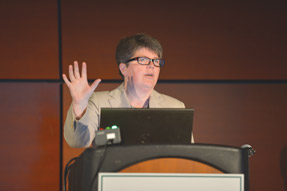6 keys to managing the cirrhotic inpatient
An expert seeks to put his fellow physicians at ease about treating a patient population that can become quite sick and require a few clinical considerations to manage.
At his session “Inpatient GI Consults: Pearls Every Internist Should Know,” Cmdr. Patrick E. Young, MD, FACP, aimed to put attendees at ease regarding cirrhotic inpatients.
“I know these folks make people a little bit nervous, because they can get quite sick,” said Dr. Young, director of the Division of Digestive Disease at Uniformed Services University of the Health Sciences in Bethesda, Md. He offered his 6 keys to managing such patients.

Manage ascites. Cirrhosis is an immunocompromised state, and patients will have a higher risk for infection at hospital admission, Dr. Young noted. “By the time they get admitted, regardless of the reason for admission, up to a third of them have SBP [spontaneous bacterial peritonitis], so you have to do paracentesis,” he said.
He also stressed that any cultures taken should be inoculated at the bedside. “Don't just put them in a sterile cup and send them down to the lab and have them do it, because there are good data showing that the yield from that is remarkably low,” he said. Loculated fluid collections may require “multiple sticks,” he said, because “tapping 1 pocket may not give you the right answer.”
If you find SBP, treatment is 25% albumin, 1.5 g/kg on day 1 and 1 g/kg on day 3, and cefotaxime or a fluoroquinolone (unless the patient was already on a fluoroquinolone for prophylaxis). Patients who have been diagnosed with SBP will need to continue prophylaxis indefinitely, Dr. Young said.
If you think a patient needs therapeutic paracentesis because of large fluid volume, remember that nature abhors a vacuum, Dr. Young told attendees. “If you pull a lot of fluid out of the belly, they're going to get arterial dilation, they're going to get hypotensive, they may get significant untoward events. It's called postparacentesis circulatory dysfunction,” he said.
To combat this, give 25 g of 25% albumin for every 5 L of fluid removed, provided kidney function is normal, he noted. In patients with renal insufficiency, use 12.5 g per each 1 to 1.5 L of fluid instead. If the patient has pulmonary hypertension, give the full dose of albumin before the fluid is removed to avoid any potential complications, Dr. Young said.
Manage upper GI bleeds. Infection rates are around 50% in cirrhotic patients with GI bleeds, so it's important to remember antibiotics, Dr. Young said. He also noted that he has a low threshold for intubating these patients because doing so helps protect the airway and allows deeper sedation. As for transfusions, you don't want to over-resuscitate people, so aim for a hemoglobin goal of 8 g/dL, he said. In addition, octreotide should be administered to decrease splanchnic pressure.
Protect the kidneys. Dr. Young said clinicians are often nervous about prescribing acetaminophen in patients with liver disease because it can cause significant liver damage in the wrong doses. He also noted, however, that it's the preferred agent for indications like fever or pain reduction, and he stressed that protecting the kidneys is especially important in patients who already have a cirrhotic liver. “You want to avoid, to the maximum extent practical, nephrotoxins,” such as nonsteroidal anti-inflammatory drugs or intravenous contrast, he said.
Vaccinate for viral hepatitis. “If somebody comes in and you notice they haven't been vaccinated for viral hepatitis, it's important to do that,” Dr. Young said. Check for immunity by looking for hepatitis B surface antibody and hepatitis A antibody, and vaccinate if the results are negative.
Investigate decompensation. “If somebody decompensates, remember GI bleed,” Dr. Young said. SBP is also a common cause of decompensation, he noted. “If you tapped them when they came in and they didn't have [SBP], and they remain in the hospital for a little while, and all of a sudden they're just not doing well for reasons you can't entirely explain, don't forget to go back and perform a paracentesis there,” he said. If the patient didn't get imaging, it's important to look for hepatocellular carcinoma, a not uncommon cause of decompensation, he noted.
Manage nutrition. Cirrhotic patients will often have protein calorie malnutrition, Dr. Young noted. “You can imagine if you have a belly full of ascites pushing on your bowels, pushing on your stomach, you're not going to feel like eating much, and most folks don't,” he said. Panenteric edema can also affect nutrient absorption. In addition, he said, weight is a poor measure of muscle mass in cirrhotic patients because fluid gain can mask muscle loss.
Dr. Young said he recommends patients consume frequent meals, snacks, and supplements. “Their stomach is kind of small and they just can't eat that much at once, so I tell them they need to graze throughout the day,” he said.
Previous recommendations called for limiting protein in cirrhotic patients because of concerns about precipitating encephalopathy, but Dr. Young noted that they are not supported by good data. “A normal amount of protein in the diet is important for cirrhotics,” he said, “so don't restrict that.”




